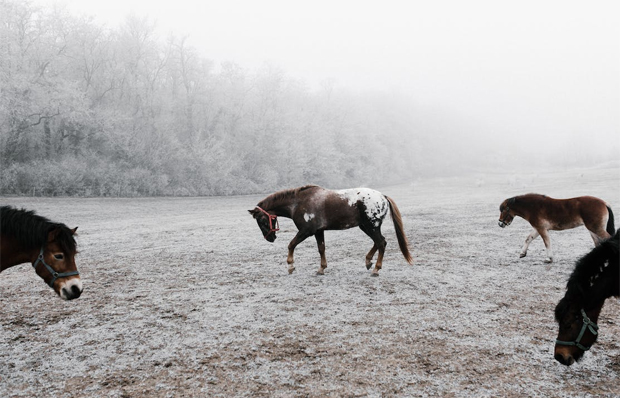Expert Winter Horse Care Tips to Keep Them Happy and Healthy

Expert Winter Horse Care Tips to Keep Them Happy and Healthy
The winter months can be a tricky period to own a horse. When you factor in colder temperatures, fewer daylight hours, and harsh winds, this season doesn’t have to be as stressful as you first thought to manage your horse. Even though the weather can be unpredictable, making a winter management plan can help keep your horse in tip-top condition during the winter and beyond.
Here are some useful tips for making life easier both for you and your horse throughout the frigid winter months.
- Provide the Correct Nutrition
Over the centuries, horses have evolved significantly, especially when it comes to their digestive system. Nowadays, horses have a digestive process that ferments their food and creates extra heat. Hay in particular provides more heat throughout the fermentation process than other food. Although it’s tempting to, it’s not advised to overload horses on concentrate or hard feed during the winter if they’re not working hard. If you do, this can lead to an array of health problems, like obesity, colic, and laminitis. To ensure the health of your horse, make sure that they get the essential nutrients in their diet by introducing foraged foods – providing them with CBD Horse Pellets can also be beneficial.
- Check Your Water Supply
Water is essential for your horse to keep hydrated in the cold as well as during the warmer months. Horses can often drink a lot more water during the winter when fed fried forages like hay. You must check their trough each day to make sure it’s clean and not frozen. To stop water from freezing when it goes below 0, it’s wise to have a small football or tennis ball left to float in the water. In some instances, incredibly low temperatures can cause taps and pipes to freeze, so keep a close eye on the weather forecast. Should it drop, it’s time to fill up emergency buckets of water to use as a backup.
- Choose the Right Horse Wear
Wearing basic horse wear is an essential part of making your pet happy. For example, saddle pads are one of the most required wears for your horse, and they not only provide a comfortable surface for the saddle to fit over, but they also protect the horse’s back from saddle sores and saddle chafing. For example, LeMieux saddle pads come with extra padding that help to distribute the rider’s weight more evenly on your pet’s back. Taking the time to put together the right outerwear for your horse and accessorising them right not only will make them look sharp, but will also ensure that you are taking care of their physical needs and providing a loving environment for your pet.
- Pick the Right Rugs
Ponies and horses have evolved to fluctuate their weight throughout the year. This enables them to adapt to the various seasons. In the spring and summer, many ponies and horses pile on additional weight and store it as fat for the winter. A horse’s innate ability to fluctuate weight can be impacted by unnecessary rug use. This can lead to long-term health complications. Not every pony or horse requires a rug. Key factors like its age, breed, and living conditions should be factored in first. If your horse does need a rug, Equi Supermarket can assist you. They sell turnout rugs, stable rugs, fleeces, and accessories that can benefit your horse.

- Provide Shelter from the Elements
Whether your horse is stabled overnight or throughout the entire year, each approach has its own merits. Deciding to turn out all year is an option for your pony or horse. However, this is only suitable if you’ve got the right shelter and forage available. Outdoor shelters do not have to be man-made structures. Instead, a group of trees can provide sufficient shelter. If you opt for a stable for your horse, make sure you’ve got low-dust bedding that’s deep enough for your horse to lie down comfortably on.
- Maintain Paddocks and Fencing
Winter and mud go hand in hand. The majority of horse owners will be well educated in trudging up and down water-logged fields on wet and windy nights and mornings. Water troughs, gateways, and hay feed inevitably become more difficult and require precise navigation for both humans and horses. For horses, these muddy and wet conditions can cause skin irritation and fungal infections. It’s your duty to check their legs regularly for sores and speak to a vet if you need advice. Make sure you put down specialist paddock mats around high-traffic zones too. Also, take a look at any fencing around the paddock on a daily basis. This is because even a tiny hole in a fence could cause extensive damage and become an escape route before long.
- Exercise According to the Weather
Ice and frost can pose a real threat, especially in the dark early mornings or winter nights. Buy a good supply of salt and grit. When it gets icy, sprinkling some on yards and walkways is a must. This makes it easier for horses and owners to walk without the risk of slipping and getting injured. In the same breath, do not ride on slippery surfaces if there is poor visibility. It’s important for your pony or horse to get out daily, either in-hand, under saddle, or in a turn-out area. Grass and regular movement are paramount for increasing gut mobility and lowering the risk of colic.
As a horse owner, you’ll want to do everything in your power to keep your stallion happy and healthy during the winter. Thankfully, we have all the bases covered above. Once you put each one into action, this will ensure your horse is kept safe and warm during the colder months.
| Guest Article. Contains placed links.





